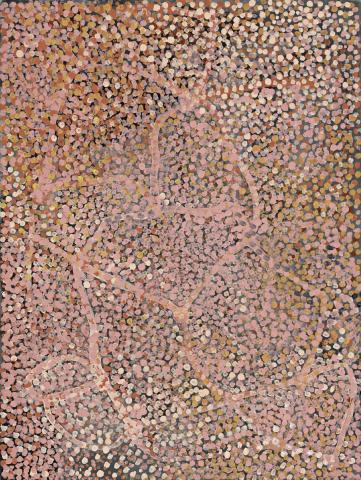SOAKAGE BORE, 1990
EMILY KAME KNGWARREYE
synthetic polymer paint on canvas
120.0 x 90.0 cm
inscribed verso: artist's name and CAAMA cat. 4-390
Commissioned by Rodney Gooch in Alice Springs, 1990
CAAMA, Alice Springs
Utopia Art Sydney, Sydney
Private collection, United States of America
This work is accompanied by a certificate of authenticity from CAAMA which states: The artist first paints the body paint designs onto the canvas, here being for a small plant which the emu feeds on – Intekwe, which is sacred to the artist. The over lying pattern represents the flowers of the intekwe plant which has covered the sacred markings.
Painted in Emily Kame Kngwarreye's first few years of moving from batik to canvas, Soakage Bore is the work of an artist well versed in the rich visual and performative culture of her own people. With a highly developed aesthetic mode of thinking, Emily Kngwarreye's painting springs from a lifetime of cultural engagement and a deep understanding of the ancestral cosmology which informs the rhythm and arc of all life. Defined by constant experimentation and innovation, Emily Kngwarreye's painting was to set the parameters of Aboriginal modernism and ignite a conversation on the nature of post-contact Aboriginal culture which would resonate around the globe.
Elegant, controlled and perceived initially as wildly enigmatic, paintings such as Soakage Bore were described by Terry Smith as deliberate 'bridgework between cultures'. To Smith this bridgework suggests parallel rather than derivative histories of Western modernism and post-contact Aboriginal art and, he argued, this is seen in the distinctive features of Emily's art - its abstraction, signature style and experimentation. He explained the formation of this Aboriginal aesthetic bridgework in terms of large-scale cultural structures -'Western modernism, Indigenous visual practices and a universal decorative impulse - that passed each other in the contact zones of Aboriginal Australia'.1
Showing the rhizome of the yam or wild potato plant, a plant to which Emily Kngwarreye's dreaming is specifically connected, Soakage Bore extends the concept of the bridge as it moves between the abstract and the representational; the ancestral and the post-colonial. Eliminating the need for written stories which had usually accompanied works by Aboriginal artists, Soakage Bore is as much concerned with the qualities of paint and the act of drawing. With its underlying net of linked shapes and the tidal fields of pink and cream across the surface, the work reads effectively as a bold gestural painting of exceptional beauty. As noted by Judith Ryan, 'Kngwarreye effected a revolution in that her extremely painterly style discouraged the interpretation of her work as any kind of map or diagram: it was no longer a notation but a form of visual music.'2
1. Smith, T. quoted in 'Aboriginal modernism? Two histories, one painter', in Neale, M., Utopia: the Genius of Emily Kame Kngwarreye, National Museum of Australia Press, Canberra, 2008, p. 27
2. Ryan, J., 'Shock of the Ancient made New', in Laverty, C., Laverty, E., and Kleimeyer, J., Beyond Sacred: Recent painting from Australia's remote Aboriginal communities: The collection of Colin and Elizabeth Laverty, Hardie Grant Books, Prahran and Bambra Press, p. 37
